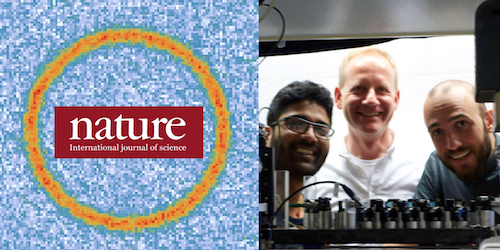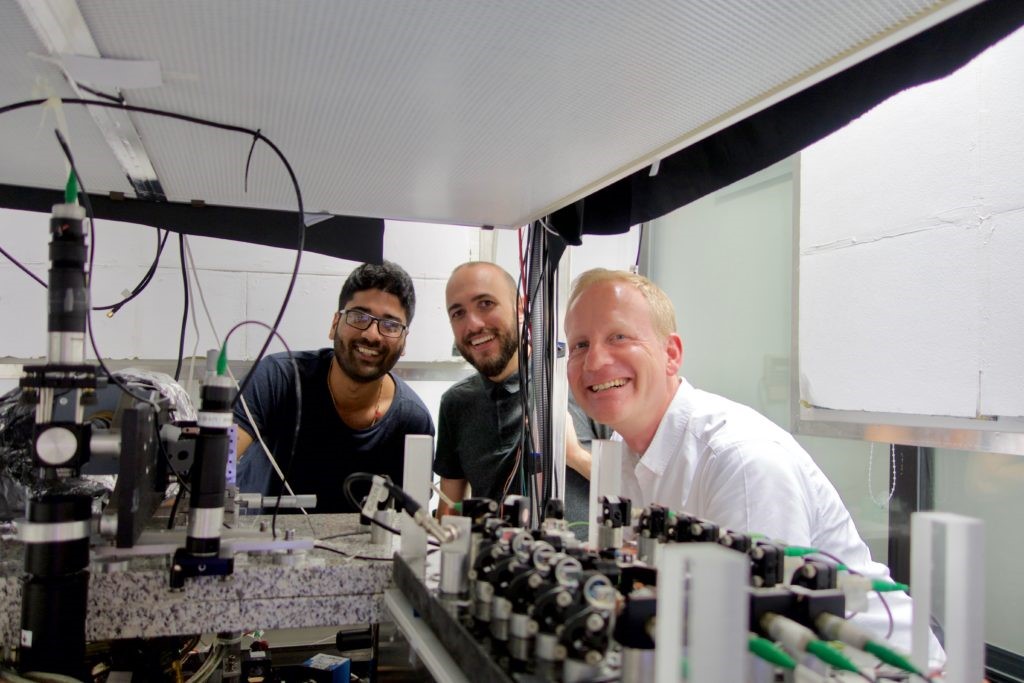
A Nature Paper by the BEC and Matterwaves Group
 Atomtronics manipulates atoms much in the way that electronics manipulates electrons. It carries the promise of highly compact quantum devices which can measure incredibly small forces or tiny rotations. Such devices might one day be used to monitor earth’s health by sensing water levels in the desert or in the search for minerals and oil. They will also be used in navigation, when GPS fails on planes or ships due to malicious attacks or simply because it is not available, e.g. in the deep seas. They might also one day act as portable quantum simulators solving complex computational tasks.
Atomtronics manipulates atoms much in the way that electronics manipulates electrons. It carries the promise of highly compact quantum devices which can measure incredibly small forces or tiny rotations. Such devices might one day be used to monitor earth’s health by sensing water levels in the desert or in the search for minerals and oil. They will also be used in navigation, when GPS fails on planes or ships due to malicious attacks or simply because it is not available, e.g. in the deep seas. They might also one day act as portable quantum simulators solving complex computational tasks.
Coherent Atomtronics manipulates atoms in the form of Matterwaves originating from Bose-Einstein Condensates (a state of matter where all the atoms lose their individual identity and become one single quantum state with all the atoms being everywhere in the condensate at the same time). The atoms in these matterwaves behave much more like waves rather than individual particles. These matterwaves can be brought to interfere and thus made to respond to the tiniest changes in their environment such as the difference in gravitational pull between light organic material and heavy iron ore. When compared to light, atoms can be 10 billion times more sensitive, e.g. to rotation or acceleration, when compared to the photons that make up light. This sensitivity depends on the measurement time and—just like Newton’s apple—atoms fall due to earth’s gravity. This forces the most sensitive interferometers to be very tall, reaching 10m and in some cases even 100 m. The possible solution would be to guide the atoms in matterwave guides, much like optical fibers guide light. Unfortunately, the fact that they are so sensitive to acceleration makes them extremely sensitive to any defects in the matterwave guides. This is why until recently, however, there were no suitable waveguides for atoms. The reason being that matterwaves are exceedingly sensitive to the smoothness.
An international team of scientists on Crete (Greece) led by Wolf von Klitzing have brought the vision of small-sized super-sensitive atomtronic devices a step closer by demonstrating the first coherent acceleration and transport of matterwaves in atomtronic waveguides. The breakthrough of the scientists at IESL-FORTH is that they used a combination of magnetic fields at different frequencies to produce so-called time-averaged adiabatic potentials (TAAP). In order to prove that these matterwave guides are perfectly smooth, they constructed a mm-sized accelerator ring for neutral matterwaves, much like the km-sized CERN accelerator for charged particles. The matterwaves reached hypersonic speeds exceeding Mach 16 (one mach = speed of sound) and guided the matterwaves for more than 40cm — an improvement of more than a factor of 1000 compared to the previous record.
The technical challenges to ready quantum technologies for ‘real-world’ applications are still enormous. The TAAP-waveguides of the Nature paper present an important step in that direction. The Cretan Mattewaves team will use this mini CERN-like accelerator ring to study fundamental physics questions such as the superfluid properties of Bose Einstein Condensates and atomic collisions. In the near future, they plan to construct a mm-sized atomtronic gyroscope and gravity sensor based on the ring.
The paper is published in Nature: 10.1038/s41586-019-1273-5
To: 20/06/2019 11:00
Atomistic calculations based on density functional theory and many-body perturbation theory provide predictive understanding of materials at the electronic level that complement experimental synthesis and characterization studies. Recent advances in modern software development and high-performance computing have enabled the high-throughput calculation of materials properties that can guide the discovery of new materials with targeted functionalities. Semiconductors in particular are a versatile class of functional materials with numerous commercial applications in electronic and optoelectronic devices. Recent interest has focused on ultrawide-band-gap semiconductors (i.e., semiconductors with gaps wider than the 3.5 eV gap of GaN) for applications in energy-efficient power electronics and deep-ultraviolet light emission for sterilization and water purification. However, existing ultrawide-band-gap semiconductors such as AlGaN alloys, Boron Nitride (BN), diamond, and Gallium Oxide (Ga2O3) face several challenges with regards to their doping, thermal conductivity, and efficiency of light generation.
In this talk I will present our recent results on the computational discovery of new ultrawide-gap semiconductors with superior properties compared to the state of the art. I will present rutile GeO2 as a promising alternative to nitrides and Ga2O3 for high-power electronic applications. I will discuss its superior electrical and thermal conductivity to Ga2O3 and the possibility of ambipolar doping. I will also discuss Boron-containing BAlGaN alloys as alternative materials to AlGaN for efficient deep-ultraviolet light emission thanks to their lattice matching to AlN (and hence their lower threading dislocation density) and the emission of transverse-electric polarized light, which facilitates light extraction from polar devices. Our computational results can guide experimental efforts in the synthesis and characterization of these promising new semiconductors.
This work was performed in collaboration with Kelsey Mengle, Sieun Chae, John Heron, Logan Williams, and Kevin Greenman. It was supported by the Designing Materials to Revolutionize and Engineer our Future (DMREF) Program under Award No. 1534221, funded by the U.S. National Science Foundation. It also used resources of the National Energy Research Scientific Computing Center, a DOE office of Science User Facility supported by the Office of Science of the U.S. Department of Energy under Contract No. DE-AC02-05CH11231.
Abstract
Το Ινστιτούτο Ηλεκτρονικής Δομής και Λέιζερ του Ιδρύματος Τεχνολογίας και Έρευνας (ΙΤΕ-ΙΗΔΛ) στo πλαίσιο εκτέλεσης των Προγραμμάτων GA 825430 NANOSMART, GA 829061 NANOPOLY, GA No 829005 IQUBITS προτίθεται να προχωρήσει, με απευθείας ανάθεση, στην αντικατάσταση μίας κρυοαντλίας (επισκευή) , με τα κάτωθι χαρακτηριστικά:
Technical Characteristics
- Cryo-Torr Cryopump, 8, 8" ANSI Flange, Chevron Frontal Array, Enhanced Array Set, Vapor Pressure Gauge, Purge Tube, Two Phase Motor (Repair & Exchange)
- KIT ADSORBER 8200/STD COMPR
Procedure
Προϋπολογισμός δαπάνης 5.476,30 ευρώ πλέον ΦΠΑ.
Επίσης, επί της καθαρής αξίας του τιμολογίου διενεργείται α) κράτηση 0,07 % υπέρ της Ενιαίας Ανεξάρτητης Αρχής Δημοσίων Συμβάσεων β) κράτηση 0,06 % υπέρ της Αρχής Εξέτασης Προδικαστικών Προσφυγών σύμφωνα με τον ν. 4412/2016. Τα ανωτέρω ποσοστά υπάγονται σε χαρτόσημο 3% και ΟΓΑ χαρτοσήμου 20% (3, 6%).
Κριτήριο επιλογής θα είναι η συμφερότερη προσφορά. Θα ληφθούν υπόψιν η συμφωνία της προσφοράς με τις τεχνικές προδιαγραφές, η ποιότητα, o χρόνος παράδοσης και εγγύησης, η τιμή.
Contact Persons
Funding

Position Description
The successful candidate will develop a detection system capable of measuring q-bits with subshot-noise precision. The candidate will be involved in theoretical treatment of the problem as well as designing and performing the experiments.
For the full announcement, follow the link ‘Related Documents’
Related Project
IQUBITS -Required Qualifications
- Demonstrated experience in precision measurements (40%)
- Experience in cold experiments (20%)
- Experiments in electronic control of complex experiments (10%)
Desirable Qualifications
- Excellent English (10%)
- Labview programming experience (10%)
- Good Knowledge of Matlab and/or Mathematica (10%)
Application Procedure
In order to be considered, the application must include:
- Completed application Form (Download link to the left)
- Brief CV
- Scanned copies of academic titles
- Reference letters (if required)
- All required forms and documents as layed out in each Job opening description
Please send your application and all documents to: hr@iesl.forth.gr and cc the Contact Person marked in the left column
Appointment Duration
6 monthsFunding

Position Description
New deadline for application (ΔΙΔΑΔ/Φ.18.31/2361/οικ.22433)
The successful candidate will study the fundamental physics of iron-based chalcogenide magnets and superconductors, made up of functional molecular components with nanoscale dimensions. For this, user-facility photon and neutron science labs will be utilized to generate key insights on how structure and spontaneous magnetic transitions influence the superconducting electron pairing. Knowledge of correlated-electron physics/materials and physical crystallography, including diffraction experiments and data analysis strategies, will be invaluable for this innovative research project. Young researches will have the opportunity to experience research collaborations with leading research groups based at US DOE labs.
For the full announcement, follow the link ‘Related Documents’
Required Qualifications
- PhD degree in Physical Sciences
- Demonstrated ability in quantitative structural analysis methods (e.g. Rietveld, pair distribution function)
- Proved experience in analytical experimental techniques, including, magnetometry and X-ray diffraction
- Excellent knowledge of the English language
- Greek male candidates must have fulfilled their military obligations
Greek male candidates must have fulfilled their military obligations
Desirable Qualifications
- Publications in peer-reviewed journals and scientific presentations in conferences is desired
- MSc degree in experimental techniques for condensed matter materials science (e.g. development of low-temperature physics probes) will be an advantage
- Programming skills for data acquisition and reduction will be beneficial
- Successful candidates must be able to work in an interdisciplinary environment
Application Procedure
In order to be considered, the application must include:
- Application Form (download Form, link to the left)
- A cover letter describing your research interests
- CV and publications list
- Two (2) reference letters, e-mailed directly to lappas@iesl.forth.gr and cc to hr@iesl.forth.gr
- Scanned copies of the ready available academic titles
Appointment Duration
12 monthsTo: 19/06/2019 11:30
Chimeras and branching are two archetypical complex phenomena that appear in many physical systems; because of their different intrinsic dynamics, they delineate opposite non-trivial limits in the complexity of wave motion and present severe challenges in predicting chaotic and singular behavior in extended physical systems. We report on the long-term forecasting capability of Long Short-Term Memory (LSTM) and reservoir computing (RC) recurrent neural networks, when they are applied to the spatiotemporal evolution of turbulent chimeras in simulated arrays of coupled superconducting quantum interference devices (SQUIDs) or lasers, and branching in the electronic flow of two-dimensional graphene with random potential. We propose a new method in which we assign one LSTM network to each system node except for “observer” nodes which provide continual “ground truth” measurements as input; we refer to this method as “Observer LSTM” (OLSTM). We demonstrate that even a small number of observers greatly improves the data-driven (model-free) long-term forecasting capability of the LSTM networks and provide the framework for a consistent comparison between the RC and LSTM methods. We find that RC requires smaller training datasets than OLSTMs, but the latter require fewer observers. Both methods are benchmarked against Feed-Forward neural networks (FNNs), also trained to make predictions with observers (OFNNs). Extensions of this method are applied in other dynamical systems.
Position Description
New deadline for application (ΔΙΔΑΔ/Φ.18.31/2361/οικ.22433)
One Technician position for design, static and dynamic simulation using finite element method (using TCAd Silvaco) on field effect transistors (FET). Measurement of electrical characteristics and extraction of parameters for custom models.
For the full announcement, follow the link ‘Related Documents’
Related Project
NANOSMART -Required Qualifications
- Basic degree in Electrical or Electronic engineering (30%)
- Postgraduate studies in Electronics engineering (25%)
- Minimum of 3 years experience in research (15%)
- Experience in using Silvaco TCAD Athena and Atlas circuit and device simulators (15%)
Desirable Qualifications
- Experience in technical support of research lab (5%)
- Prior experience in verilog-A (5%)
- Knowledge of software development (in programming languages such as Python, Java) for collection and analysis of measured data (5%)
Application Procedure
In order to be considered, the application must include:
- Completed application Form (Download link to the left)
- Brief CV
- Scanned copies of academic titles
- Reference letters (if required)
- All required forms and documents as layed out in each Job opening description
Please send your application and all documents to: hr@iesl.forth.gr and cc the Scientific supervisor marked in the left column
Appointment Duration
5 monthsFunding



